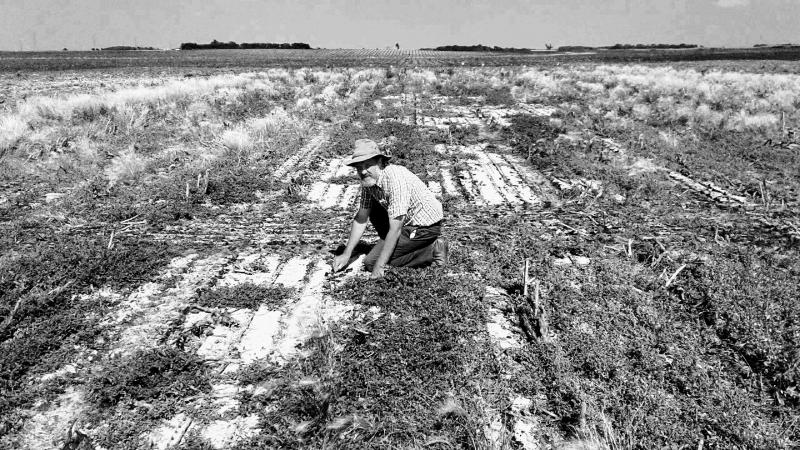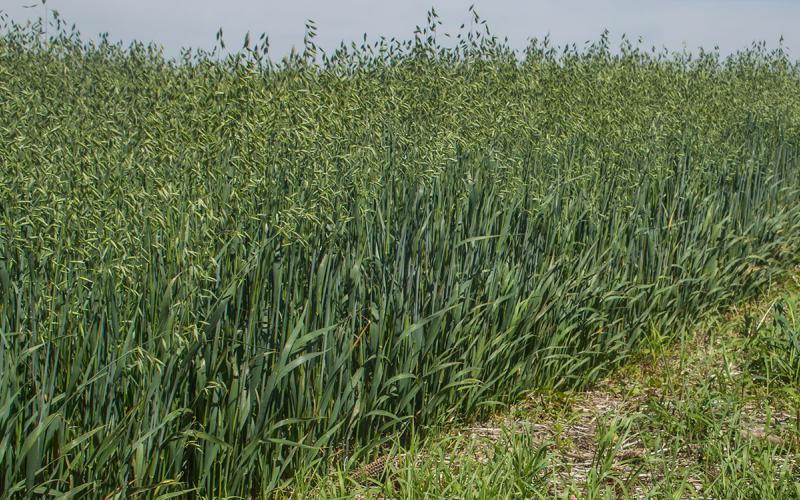
Originally written with contributions by Gared Shaffer, former SDSU Extension Weeds Field Specialist.
Reclaiming marginal lands, especially those considered saline or sodic can be very challenging and may take many years to accomplish. Soil salinity issues often result from upward salt movement as water evaporates on the soil surface. In order to prevent this, deep-rooted perennial plants can be used to utilize excess soil moisture, rather than leaving areas fallow. The key to turning around salt or alkali areas in your fields, begins with getting a living root established in the affected area. Once plants are established in or near the outside boundaries of a salty area, perennials slow water movement into the highly affected areas and prevent accumulation of more salts. This helps salt tolerant, deep-rooted plant species to slowly spread across the area, allowing the land to heal over time. With proper management, saline areas may once again grow a forage or field crop successfully, however long-term management changes may be required.
‘Salt tolerance’ is considered the ability of a plant to endure the effects of excess salts in the soil while still producing satisfactory yield (NRCS, 2010). Although most plants tolerate little to no ground salts, some plants are much more tolerant than others.Many perennial species are capable of living in alkali soils, however not all species are ideal for any particular cropping system. In South Dakota, the Every Acre Counts program has developed perennial plant mixes suited for various types of marginal land situations including saline/wet soil areas. Table 1 serves an example of a proposed saline/wet soil mix for South Dakota per the Every Acre Counts program.
|
|
||
|---|---|---|
| Common Name | Variety |
|
| Falcata Alfalfa | Sholty |
|
| Alfalfa | SalinityMax |
|
| Green Wheatgrass | AC Saltlander |
|
| Creeping Foxtail | Garrison |
|
| Intermediate Wheatgrass | Oahe |
|
| Tall Wheatgrass | Alkar |
|
| Barley | Tradition |
|
| Common Milkweed | - |
|
| Slender Wheatgrass | Revenue |
|
| Switchgrass | Sunburst |
|
|
|
|
|
Generally, late fall is considered the most ideal time to plant forage type species into saline/wet soils. If a fall planting is not possible, winter dormant seeding can work as well if a snow-free period is available. Be sure the seedbed is ideal, ie: weed free, firm, and somewhat level.
Keep in mind, this type of conservation effort is not a fast process. While these perennial mixes may establish better than other plants in marginal areas, they still must acquire reasonable amounts of sunlight and moisture and may be slow to establish in some areas. Depending on the salinity levels in the soils, plants may develop at different rates and can oftentimes be less palatable during first few growing seasons, as slower growth caused by salts, could cause forages to be tougher and less palatable.
There are many forage species that can adapt to salty areas, and to say that there is one specific mix that fits all circumstances would be impractical. However, the above listed mixture helps to spread the germination risk across species within the mix and is a well-adapted combination of salt tolerant species within South Dakota. There are numerous recommended perennial plant species that may establish well on saline or sodic soils, for a full list and additional information on this topic view this USDA-NRCS Technical Note. For information on the Every Acre Counts program in South Dakota please contact Anthony Bly.
Resources/References:
- Plants for Saline to Sodic Soil Conditions, USDA-NRCS, 2010.
- Planting Suitable Salt-Tolerant Crops Based on Soil Salinity Levels, NDSU, 2019.

